The following is an invited article by Randall E. Brummet of the WorldFish Center in Cameroon.
|
Editors’ note The ornamental fish sector is an extensive and global component of international trade, fisheries, aquaculture and development. However, the scope of this sector and the impact on human and aquatic communities are often unappreciated and often not accurately known. Global statistics reported to FAO from Members indicate that the export value in 1996 of ornamental fishes was US$ 206 603 000.00. Since 1985 the value of the international trade in ornamental exports has increased at an average growth rate of approximately 14 percent per year. Developing countries account for about 63 percent of the export value. The value of the entire industry, when non-exported product, wages, retail sales and associated materials are considered has been estimated at US$ 15 000 000 000.00. Such a vast and important industry has the potential to contribute to the sustainable development of aquatic resources, but may face challenges due to increased attention to environmental and social issues. FAO Fisheries has not been actively involved with the ornamental fish industry other than maintaining import and export statistics and some publications[19]. However, the issues that Mr Randy Brummet raises below are of concern and indicate that there may be opportunities to use the ornamental fish sector to help improve livelihoods. We thank Mr Brummet for his contribution. |
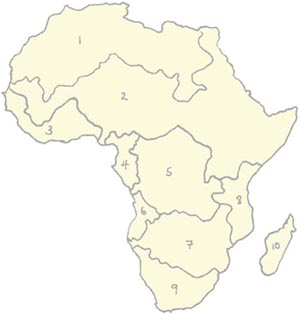
Figure 1. The Ichthyological provinces of Africa, based on Roberts (1975) as modified by Lévêque (1997) and redrawn according to new hydrological basin mapping published by FAO (2000). 1 = Maghreb, 2 = Nilo-Sudan, 3 = Upper Guinea, 4 = Lower Guinea, 5 = Congo Basin, 6 = Quanza, 7 = Zambezi, 8 = East Coast, 9 = Southern, 10 = Malagasy.
In addition to some 8 million people, the Lower Guinea Rainforest (Fig. 1) harbours 400 mammal species, 1,000 bird species and over 10,000 species of plant (CARPE 2001). From the available literature, 29 families, 119 genera and some 500 species of fish have been reported (Teugels & Guégan 1994). Apart from the large number of small cyprinodonts (of which 70 percent are from the genus Aphiosemion), the freshwater fauna is dominated by the Siluriformes (6 families, 23 genera, ±100 species), the Characiformes (2 families, 20 genera, ±60 species), the Cichlidae (17 genera, ±50 species) the Cyprinidae (10 genera, ±80 species) and the Mormyridae (14 genera, ±50 species)[20]. Conservation International lists the Guinea Rainforest as a Global Biodiversity Hotspot.
However, much of this biodiversity is coming under threat even before it is completely documented (Stiassny 1996). Alien species (esp. Oreochromis niloticus, Clarias gariepinus & Heterotis niloticus), introduced for aquaculture and accidentally released into the Nyong River, have contributed to the disappearance of several indigenous species from commercial catches. In addition, the use of fish poisons has become increasingly frequent. Some of these are from local plants and cause only temporary harm, but most poisoners now use Lindane or Gammelin 20, an organochlorine insecticide used in cocoa production and highly destructive of the entire foodweb. Human deaths have been reported as a result of eating poisoned fish, and on the Ntem River in Southern Cameroon, insecticide fishing disrupted local aquatic ecosystems to the point where the electric catfish, Malapterurus electricus was able to extend its habitat into the small rivers where they were previously not found. Because of the powerful shocks emitted by this fish, women have been forced to abandon their traditional dam fishing in the area.
The greatest threat, however, comes from irresponsible logging. The Lower Guinea has already lost an estimated 46 percent of its forest cover to logging and conversion to agriculture and continues to lose forested watershed at an average rate of 7 percent per year (Revenga et al. 1998). In the process of removing the valuable timber, these (often illegal) logging operations also expose large amounts of bare earth and alter stream courses, increasing runoff and siltation. Road construction, saw mills and other infrastructure associated with logging attracts people into the forest, resulting in wholesale transformation of the ecosystem (Burns 1972; Garman & Moring 1993).
Against this backdrop, the WorldFish Centre in partnership with the UK Department for International Development (DFID), l’Institut de Recherche Agricole pour le Développement (IRAD), l’Institut de Recherche pour la Développement (IRD, France), the WorldWide Fund for Nature (WWF), the American Museum of Natural History, the Musée Royale pour l’Afrique Centrale (Tervuren, Belgium) and the Organization for Environment and Sustainable Development (OPED), a local NGO, has been studying the biogeography, ecology and management of the rainforest rivers of the Lower Guinea Ichthyological Province in Southern Cameroon. A comprehensive review of the existing knowledge about this ecosystem was published by Brummett & Teugels (2004) and upon that base a series of field research projects are endeavouring to create new sustainable livelihoods options for rainforest communities that will raise revenues and conserve biodiversity, the ultimate goal being to establish functional village-based monitoring and management programs that would ensure the sustainability of commercialised and diversified natural resource exploitation. This article is a synopsis of key findings to date and progress on the implementation of a socially, economically and ecologically sound management plan for Lower Guinea Rainforest rivers.
Current Exploitation
Welcomme (1976) estimated the total number of first order rainforest streams at over 4 million with a combined total length equal to half of all watercourses in Africa, making these the largest single riverine ecosystem on the continent. Of the 8 million people who live in the Lower Guinea forest, 20 percent are more or less fulltime fishers and another 70 percent (mostly women and children) fish seasonally. Estimates from Cameroon put the productivity of capture fisheries in forest river basins at 0.5 tons/km2/yr (Mdaihli et al. 2003) or 260 000 tons for the entire forest. At the local retail price for fresh foodfish of approximately $2.00 per kg, this translates into a cash value of over $500 million per year.
Fishing in rainforest rivers is severely constrained by the large quantities of wood that decorate the streambed. By far the most common types of gear are passive set nets, traps and hook-lines of which there are a great variety in accordance with the diversity of the fish fauna. Also common, is a hook-and-line fishery dominated by small children and mainly targeting immature cichlids.
In Southern Cameroon, the main fishing seasons are during reproductive migrations ("dok") which take place as waters rise in May and October. Doks involving Labeo batesii and Distichodus spp. have been documented in the Upper Cross and the Ntem, respectively,(du Feu 2001, Djama 2001). There are two traditional fisheries allocated almost entirely to women. One, the "alok", involves the construction of small earthen dams across first order forest streams during the dry seasons (January-April & July-August) to capture small Channids, Clariids and Mastecembelids (van Dijk 1999). The other female-dominated fishery is the use of woven basket traps ("aya") to catch the freshwater prawn, Macrobrachium vollenhovenii.
There is also a limited trade in ornamental fishes, dominated by middlemen based in the commercial capital, Douala. These entrepreneurs work with a handful of expert fishers who know where and when to find the fish. These men travel back and forth between the town and the forest, leaving orders for village women and children to fill and then coming back in a few days to collect the fish, paying the villagers a pittance for their work. Captured fish are typically held in tanks in Douala for a period of days prior to packing and shipping by air to Europe, where the poor handling they endure often results in mortalities of up to 85 percent.
Currently, fishing communities have limited regulatory authority over the rivers they fish. Some traditional rules apply, but these are easily and often used to create inequalities by leaders who have mostly moved into town and exert their influence only through proxies. Logging companies and poachers have found an easy opportunity to exploit the forest without regard for local communities or the integrity of the forest and the associated riverine ecosystem upon which they depend for their livelihoods.
Figure 2. A few of the lower guinea Rainforest fishes of potential interest to the international ornamental fish trade

A Brycinus longipinnis (Tai National Park, Ivory Coast)
Karsten Mody
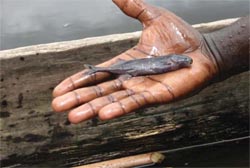
B Brienomyrus brachyistus
R.E. Brummett
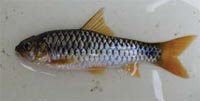
C Barbus camptacanthus
R.E. Brummett
Seeking Sustainability
A key aspect of sustainable management systems is the valuation of resources from the point of view of indigenous people (Sheil & Wunder 2002). A first step in revaluing forest resources and enforcing sustainable management is the quantification of the biodiversity in question. Several attempts have been made at the generation of a workable Index of Biotic Integrity (IBI) such as that used to track changes in temperate zone streams, but parameterization has been a problem. The best effort to date in Central Africa is that of Kamdem-Toham & Teugels (1999), but gaps still exist. Existing datasets on aquatic biodiversity and ecology in Central Africa are weak, at best, and this makes it very difficult to develop quantitative tools (Lévêque 1997).
Coupled with this quantification/valuation exercise should be the development of improved management and exploitation strategies that could actually increase the value of aquatic ecosystems and justify their preservation, while at the same time improving rural livelihoods. Forest river ecosystems are currently unmanaged and unregulated in any formal sense (M.O. Baba, Director of Fisheries, personal communication, Yaoundé, April 2002), the most widely promoted method of increasing the productivity of aquatic ecosystems in Central Africa being to increase fishing pressure through the introduction of subsidies on motors and other fishing equipment, and this without any clear idea as to the size of the resource or level of current exploitation.
While some increased pressure might be warranted in some areas, the upper limit for this strategy is probably already in sight for most places. Careful regulation of fishing gear and seasons based on scientific data might be a more widely applicable strategy for increasing catches of certain species in some rivers. The greatest potential for improving profitability while conserving ecosystems might lie with species of value as ornamental aquarium fishes.
Aquariums for Poverty Reduction?
Fishes with potential as ornamentals are unusually abundant in African rainforest rivers (Fig. 2) and wholesale at an average of $2.43 per fish. Keeping prices high and availability low is the difficulty involved in the capture, holding and transport or African river fishes.
More importantly, reproduction of forest river fishes has been difficult or impossible for the large commercial breeders in Singapore and Florida, most likely due to the fact that outside of the special and complex rainforest ecosystem, these fishes seldom reach sexual maturity.
Among those so far identified, several genera are of particular interest to the ornamental fish trade, including: Aphyosemion, Benitochromis, Brienomyrus, Brycinnus, Epiplatys, Mastecembelus, Chiloglanis, Doumea, Neolebias, Parauchenoglanis, Pelvicachromis and Procatopus. Retail value of these fishes range from $2.00 to $20.00 in Europe. Partial enterprise budgeting for a delivery of 8.5 kg of ornamentals (the minimum amount to obtain discounted air freight) sold wholesale at $1.00 per fish shows a substantial potential for profitability (Table 1).
Table 1. Partial enterprise budget for ornamental fish export from Cameroon to Germany
|
Costs |
||
|
Shipping per 208.5 kg (100 l water + fish + containers » 5 boxes) @ $3.00/kg |
$ |
600 |
|
Veterinary fees in Germany |
$ |
30 |
|
Local transport (300 km x $0.16/km) |
$ |
48 |
|
Fish feeds |
$ |
22 |
|
Maintenance |
$ |
100 |
|
Payment to fishers ($0.25 per fish) |
$ |
425 |
|
Government Tax (as of January 2005) |
$ |
100 |
|
Total |
$ |
1,225 |
|
Revenues |
||
|
Wholesale of 1700 fish (@ 5 g x $1.00 per fish) |
$ |
1,700 |
|
Profit per five boxes shipped |
$ |
375 |
The typical problem facing small-scale natural resource businesses is competition with unregulated poachers and larger-scale investors once markets are developed and the profitability of a product demonstrated (Sunderland & Ndoye 2004). Luckily, or unluckily, a recent survey of low order forest rivers in SW Cameroon found that the total value of the ornamental fish species existing in the wild at any of the sites sampled is insufficient to support any significant expansion of the current exploitation rate. Most of these species have very low fecundity and cannot be expected to rapidly repopulate heavily exploited streams (Kamdem-Toham & Teugels 1998).
Figure 3. Some of the communities currently involved in the development of village-based ornamental fish businesses
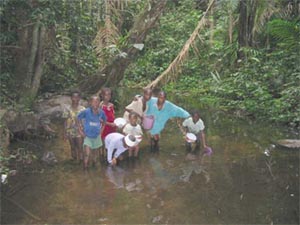
Nkoelon Fish Club, N’tem River
R.E. Brummett
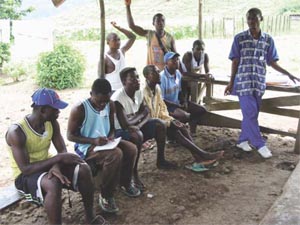
Camp 7 Aquarium Fish Company, Moliwe River
R.E. Brummett

Monatelé Ladies Fishing Association, Sanaga River
R.E. Brummett
Capture and export of wild-caught fish can thus only be profitable for a very few individuals, and is unlikely to add sufficient value at the community level to justify conservation.
Aquaculture might represent a viable alternative. By using existing fish reproduction and nursing technology, sexually mature broodfish of rarer and more valuable species captured from rainforest rivers can be artificially reproduced. Subsequent export of only those individuals reared in captivity will not only protect against over-exploitation of natural stocks. Because sexually mature broodstock will continue to be available only from the wild, local incentives to protect the ecological integrity of the river will be strong. International oversight and certification of exported fish as cultured will help ensure a competitive advantage to those producers who operate responsibly.
Based on these findings, WorldFish and its partners are currently piloting efforts to develop a socially, economically and environmentally sound strategy for the development of ornamental fish aquaculture in Cameroon. Expert fishers have been enlisted and are working directly with OPED and village groups consisting primarily of women and youth to develop and implement a viable business plan, which will replace the Douala middlemen with locally-based management entities (Fig. 3). Based on a quantitative stock assessment, a river management and monitoring plan is also being developed, to ensure the sustainability of this new enterprise, and to learn more about the aquatic biodiversity of the Lower Guinea rainforest.
For more information, contact:
R.E. Brummett, Humid Forest Ecoregional Center, BP 2008 (Messa), Yaoundé, Cameroon or
J. Syapze, Organization for the Environment and Sustainable Development, BP 12675, Yaoundé, Cameroon.
REFERENCES
Brummett, R.E. & Teugels, G.G. 2004. Rainforest rivers of Central Africa: biogeography and sustainable exploitation, pp 149-171. In: WELCOMME, R. & PETR, T. (eds) Proceedings of the Second International Symposium on the Management of Large Rivers for Fisheries. RAP 2004/16, Food & Agriculture Organization of the United Nations, Bangkok, Thailand.
Burns, J.W. 1972. Some effects of logging and associated road construction on northern California streams. Transactions of the American Fisheries Society 101(1): 1-17.
CARPE. 2001. Congo basin information series. Central African Regional Program for the Environment. World Wildlife Fund, Gland, Switzerland.
Djama, T. 2001. Inventaire qualitatif de poisons dans l’UTO Campo-Ma’an. Document 11. Project d’Aménagement et de Conservation de la Biodiversité de Campo-Ma’an, Kribi, Cameroun.
Du Feu, T.A. 2001. Fish and fisheries in the southern zone of the Takamanda Forest Reserve, Southwest Cameroon. Consultant’s report to the Cameroonian-German project: Protection of Forests around Akwaya (PROFA), GTZ, Yaoundé, Cameroun.
FAO. 2000. African major hydrological basins. http://apps3.fao.org/faomap/. Food and Agriculture Organization of the United Nations, Rome, Italy.
Garman, G.D. & Moring, J. R. 1993. Diet and annual production of two boreal river fishes following clearcut logging. Environmental Biology of Fishes 36: 301-311.
Kamden-Toham, A. & Teugels, G.G. 1998. Diversity patterns of fish assemblages in the Lower Ntem River Basin (Cameroon), with notes on potential effects of deforestation. Archives of Hydrobiology 141(4): 421-446.
Kamden-Toham, A. & Teugels, G.G. 1999. First data on an index of biotic integrity (IBI) based on fish assemblages for the assessment of the impact of deforestation in a tropical West African river system. Hydrobiologia 397: 29-38.
Leveque, C. 1997. Biodiversity dynamics and conservation: the freshwater fishes of tropical Africa. Cambridge University Press, Cambridge, UK.
Mdaihli, M., Du Feu, T. & Ayeni, J.S.O. 2003. Fisheries in the southern border zone of Takamanda Forest REserve, Cameroon, pp 141-154. In: Comiskey, J.A., Sunderland, T.C.H. & Sunderland-Groves, J.L. (eds). Takamanda: the biodiversity of an African rainforest. SI/MAB Series #8, Smithsonian Institution, Washington, DC.
Revenga, C., Murray, S., Abramovitz, J. & Hammond, A. 1998. Watersheds of the world; ecological value and vulnerability. World Resources Institute, Washington DC, USA.
Roberts, T.R. 1975. Geographical distribution of African freshwater fishes. Zoological Journal of the Linnaean Society 57: 249-319.
Sheil, D. & Wunder, S. 2002. The value of tropical forest to local communities: complications, caveats and cautions. Conservation Ecology 6(2): 9 online (URL: http://www.consecol.org/vol16/iss2/art9).
Stiassny, M.L.J. 1996. An overview of freshwater biodiversity: with some lessons from African fishes. Fisheries 21(9): 7-13.
Sunderland, T. & Ndoye, O. (eds.). 2004. Forest products, livelihoods and conservation, volume 2-Africa. Center for International Forestry Research, Bogor Barat, Indonesia.
Teugels, G.G. & Geugan, J.-F. 1994. Diversité biologique des poisons d’eaux douces de la Basse Guinée et de l’Afrique Centrale, pp 67-85. In: Teugels, G.G., Guegan, J.-F. & Albaret, J.-J. (eds). Diversité Biologique des Poissons des Eaux Douces et Saumâtres d’Afrique. Annales Sciences Zoologiques 275, Musée Royal de L’Afrique Centrale, Tervuren, Belgium.
Van Dijk, J.F.W. 1999. Non-timber forest products in the Bipindi-Akom II region, Cameroon; a socio-economic and ecological assessment. Ponsen en Looijen, Wageningen, The Netherlands, 197 pp.
Welcomme, R.L. 1976. Some general and theoretical considerations on the fish yield of African rivers. Journal of Fish Biology 8: 351-364.
| [18] Randall E. Brummett
e - mail: [email protected] [19] See the following relevant publications Bartley, D.M. 2004. Responsible ornamental fisheries. FAO Aquaculture Newsletter 24:10 - 14. and Chao, N.L., Petry, P., Prang, G., Sonneschien. L. & Tlusty, M. 2001. Conservation and Management of Ornamental Fish Resources of the Rio Negro Basin, Amazonia, Brazil - Project Piaba. Manaus, Amazonas Brazil: Editoria da Universidade de Amazonas, Manaus, Brazil. 310 p. [20] The piscine biodiversity of the Lower Guinea Rainforest is not well sampled and what samples do exist are currently under review; hence the numbers indicated are only approximate. |